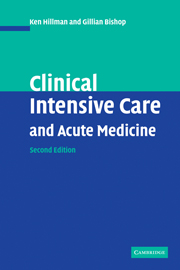Book contents
- Frontmatter
- Contents
- List of troubleshooting tips
- Preface to the first edition
- Preface to the second edition
- Acknowledgements
- 1 A systematic approach to caring for the seriously ill
- 2 Organisation of an intensive care unit
- 3 Routine care of the seriously ill
- 4 Fluid therapy and electrolytes
- 5 Nutrition and metabolism
- 6 Acid–base balance
- 7 Sedation, analgesia and muscle relaxants
- 8 Shock and anaphylaxis
- 9 Multiorgan failure
- 10 Cardiopulmonary resuscitation
- 11 Body temperature disorders
- 12 Transport of the seriously ill
- 13 Infection
- 14 Trauma
- 15 Poisoning
- 16 Acute respiratory failure
- 17 Interpretation of the portable chest film
- 18 Specific respiratory problems
- 19 Ventilatory techniques
- 20 Cardiorespiratory monitoring
- 21 Acute cardiovascular failure
- 22 Specific cardiovascular problems
- 23 Acute intracranial disasters
- 24 Specific intracranial problems
- 25 Critical care neurology
- 26 Acute renal failure
- 27 Critical care gastroenterology
- 28 Critical care haematology
- 29 Critical care endocrinology
- 30 Obstetric emergencies
- 31 Economics, outcome and ethics in intensive care
- Appendices
- Index
- References
29 - Critical care endocrinology
Published online by Cambridge University Press: 07 September 2009
- Frontmatter
- Contents
- List of troubleshooting tips
- Preface to the first edition
- Preface to the second edition
- Acknowledgements
- 1 A systematic approach to caring for the seriously ill
- 2 Organisation of an intensive care unit
- 3 Routine care of the seriously ill
- 4 Fluid therapy and electrolytes
- 5 Nutrition and metabolism
- 6 Acid–base balance
- 7 Sedation, analgesia and muscle relaxants
- 8 Shock and anaphylaxis
- 9 Multiorgan failure
- 10 Cardiopulmonary resuscitation
- 11 Body temperature disorders
- 12 Transport of the seriously ill
- 13 Infection
- 14 Trauma
- 15 Poisoning
- 16 Acute respiratory failure
- 17 Interpretation of the portable chest film
- 18 Specific respiratory problems
- 19 Ventilatory techniques
- 20 Cardiorespiratory monitoring
- 21 Acute cardiovascular failure
- 22 Specific cardiovascular problems
- 23 Acute intracranial disasters
- 24 Specific intracranial problems
- 25 Critical care neurology
- 26 Acute renal failure
- 27 Critical care gastroenterology
- 28 Critical care haematology
- 29 Critical care endocrinology
- 30 Obstetric emergencies
- 31 Economics, outcome and ethics in intensive care
- Appendices
- Index
- References
Summary
Severe uncontrolled diabetes
Pathophysiology
Most diabetic emergencies arise as a result of insulin deficiency, either absolute or relative, that causes decreased uptake of glucose into the cells and via increased glucagon secretion, an increase in hepatic glycogenolysis and gluconeogenesis (Figure 29.1). Increased amounts of regulatory hormones such as catecholamines and cortisol, are released in response to glucagon excess. These hormones, along with the decreased insulin concentration, stimulate lipolysis and generation of fatty acids. Oxidation of these fatty acids in the liver results in ketone body formation and metabolic acidosis. Hyperosmolar hypoglycaemic non-ketotic coma (HHNKC) occurs as a result of relative insulin deficiency or resistance but with minimal counter-regulatory hormonal activation.
An increased serum glucose concentration will lead to osmotic diuresis with extensive water losses, equally from all of the body's fluid compartments. Poor tissue perfusion will eventually lead to lactate formation which, in turn, will exacerbate the metabolic acidosis. The metabolic acidosis will also lead to decreased total body levels of potassium and magnesium as these ions not only are exchanged for extracellular hydrogen ions but also are lost in the urine as a result of the osmotic diuresis, along with sodium, water, phosphate and glucose.
Clinical features
A wide spectrum of biochemical and clinical abnormalities can occur in acute uncontrolled diabetes (Table 29.1), extending from pure hyperglycaemia without ketosis or HHNKC to pure ketosis without hyperglycaemia (euglycaemic ketoacidosis).
- Type
- Chapter
- Information
- Clinical Intensive Care and Acute Medicine , pp. 597 - 612Publisher: Cambridge University PressPrint publication year: 2004



